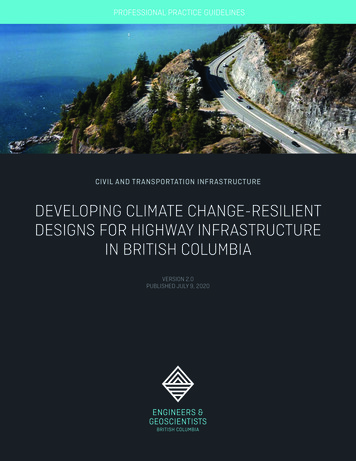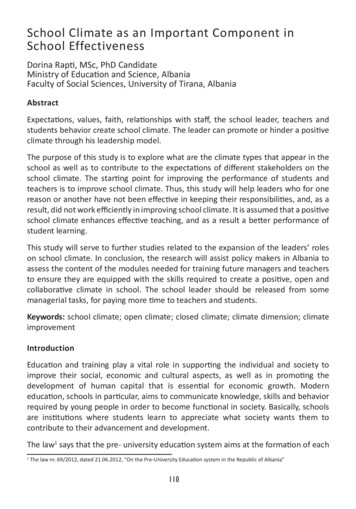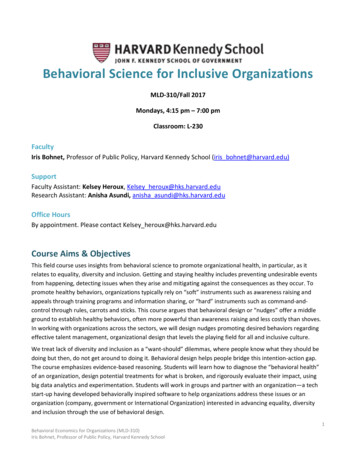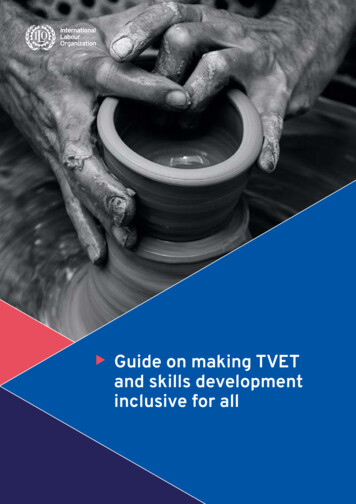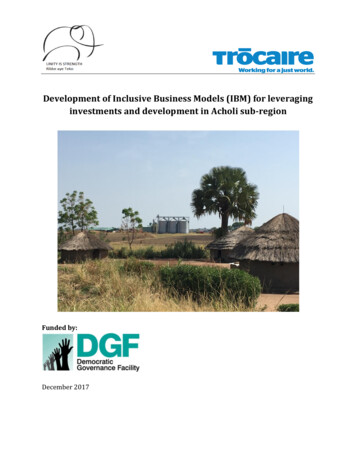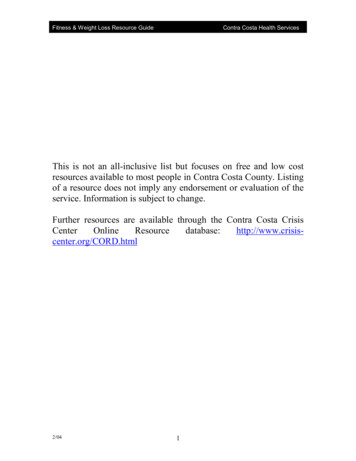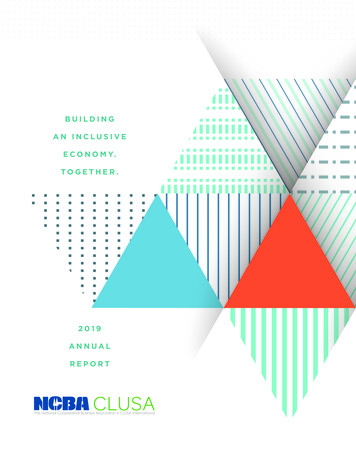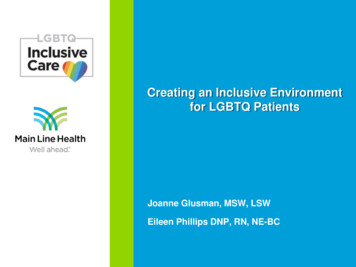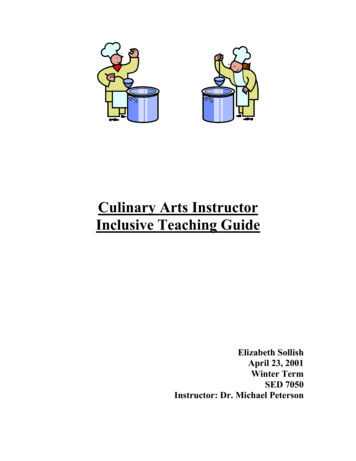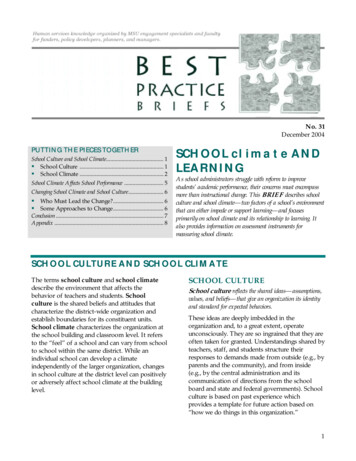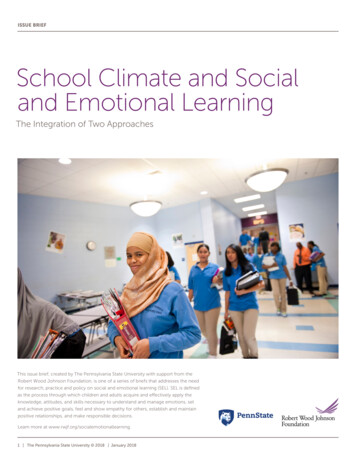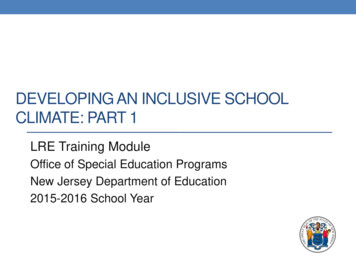
Transcription
DEVELOPING AN INCLUSIVE SCHOOLCLIMATE: PART 1LRE Training ModuleOffice of Special Education ProgramsNew Jersey Department of Education2015-2016 School Year
NJDOE OSEP 2015-20162Welcome! What You Need Before WeBegin Before we get started, make sure you have copies of the following handouts for your reference:Handout 1: PowerPointHandout 2: Think-Pair-ShareHandout 3: New Jersey School Climate SurveyFact SheetHandout 4: NJ School Climate Survey StaffHandout 5: NJ School Climate Survey StudentHandout 6: NJ School Climate Survey Parent
NJDOE OSEP 2015-20163Workshop Goals To identify examples of school climate factors, practices,programs and strategies associated with inclusion; To understand the importance of supporting a school-based, multidisciplinary leadership team to establish andimplement a goal-driven plan to improve the school’sinclusive climate; To identify the domains of the NJDOE School ClimateSurvey;
NJDOE OSEP 2015-20164Workshop Goals To identify a tiered system of support such as PositiveBehavior Interventions and Supports, designed to meetthe needs of all students in the school.
NJDOE OSEP 2015-2016What is SWIFT?5
NJDOE OSEP 2015-2016Inclusive School Climate6
7NJDOE OSEP 2015-2016Why Inclusive School Climate?If NJDOEProvides trainingand technicalassistance onproactivetechniques thatreinforce a positivebehavior approachand a culture in thegeneral educationclassroom that isresponsive insupport of alllearnersThenThen more schools willimplement a schoolwide, positivebehavioral supportsystem students withbehavioral oremotional difficultieswill be supported withinterventions that aretargeted andevidence-based LEAs will becomebetter equipped atimplementing theSchool ClimateSurvey leading togreater accuracy ofresults removal ofstudents with IEPsfrom classrooms andschools fordisciplinary reasonswill be reduced students will referrals to theexperience greateroffice for all studentssuccess in utilizingwill decreaseresearch-proven desescalation techniquesThen an increasedpercentage ofstudents with IEPswill benefit fromeducation ingeneral educationsettings for agreater percentageof their school day.
NJDOE OSEP 2015-20168Educating Students with Disabilities Educating students with disabilities together with typically developingpeers has been a principle objective since the 1997 Reauthorizationof the Individuals with Disabilities Education Act (IDEA). New Jersey Administrative Code (N.J.A.C. 6A:14) requires thatstudents with disabilities are educated in the least restrictiveenvironment. An essential element is the provision that district boards of educationensure that, to the maximum extent appropriate, a student with adisability is educated with children who are not disabled (N.J.A.C.6A:14-4.2(a)1). Federal and New Jersey courts have upheld andreinforced this provision.
NJDOE OSEP 2015-20169Developing an Inclusive School Climate As the trend to educate students with disabilities ininclusive settings has increased, the need to support theacademic, social, and emotional success of students withdisabilities has become even more critical. Through the lens of school climate, NJOSEP is able tofocus on creating a positive learning environment whereall students better understand one another, feel safe andsupported, have positive relationships, and are morerespectful and accepting of each other.
NJDOE OSEP 2015-201610Inclusion Inclusionrefers to the provision of qualityinstruction through an appropriate deliverysystem and relevant supports to students withdisabilities so they have access to the generaleducation classroom and curriculum to achievepositive educational outcomes. There is growing agreement that inclusion shouldnot be conceptualized simply as the place whereteaching and learning occurs. (McLeskey, Landers, Williamson, & Hoppey, 2012; Soukup, Wehmeyer, Bashinski, &Bovaird, 2007; Zigmond, 2003)
NJDOE OSEP 2015-201611Think, Pair, ShareYou have been invited to a dinner party by a friend and thisfriend has invited twelve other friends.Scenario (1): You arrive and he shows you the wine, the cheeseand says “mingle and have fun”, and then walks away.Scenario (2): You arrive and he introduces you to the otherguests and while he is doing so, he tells each person what theyhave in common with each other, so as to break the ice.
NJDOE OSEP 2015-201612Think, Pair, Share Which of the two scenarios will cause you to stayat the party longer and why? Assume you are the host of the party, What stepscould you take to make your guests feel welcomeand included? Now think of your school, what steps could youtake at your school to make your staff andstudents feel included?
NJDOE OSEP 2015-201613Definition of School Climate Quality and character of school life; Based on patterns of students’, parents’, andschool personnel’s experience of school life; Reflects norms, goals, values, interpersonalrelationships, teaching and learning practices,and organizational structures. (NJDOE, Office of Student Support Services)
NJDOE OSEP 2015-201614Inclusion, School Climate, and DisabilityAwareness Schools successfully involved in inclusion foster a shared vision,create structures for staff collaboration, encourage professionaldevelopment, make use of data-based decision making, have leadersthat lead by example, promote learning communities, and valuesustainability.(Furney, Aiken, Hasazi, & Clark-Keefe, 2005; Hoppey & McLeskey, 2013;Salisbury & McGregor, 2002; Waldron & McLeskey, 2010) A culture of collaboration, administrative support, commitment to thesuccess of every student and the availability of programs/activitiesfor all students are critical factors for an inclusive school climate.(Burstein, Sears, Wilcoxen, Cabello, & Spagna, 2004; Friend & Cook, 2003;Miller & Schlein, 1999; Pivik, McComas, & LaFlamme, 2002) Co-teaching models that combine the expertise of special and generaleducators can benefit all students.(Volonino & Zigmond, 2007; Zigmond & Baker, 1995)
NJDOE OSEP 2015-201615NJDOE School Climate Survey (NJSCS) Was developed in 2012 and revised in 2014. It is designed to collect and analyze objective information fromdiverse school populations for reinforcing positive conditionsand addressing vulnerabilities in local conditions for learning. Four different surveys Grades 3-5 (students) Grades 6-12 (students) Staff Parents It is a free resource. Additional materials to supportadministration and analysis of the survey are available ety/behavior/njscs
NJDOE OSEP 2015-201616NJDOE School Climate Survey (NJSCS)The Survey is comprised of 8 Domains: Physical Environment; Teaching and Learning Capability; Morale in the School Community, Quality of Relationships; Level of Parental Support and Engagement; Safety Situation; Emotional Environment, and; Perception of Administration Support.
NJDOE OSEP 2015-201617NJDOE School Climate Survey (NJSCS) Let’s take a look at information from the afety/behavior/njscs/NJSCS Admin Guide.pdf
NJDOE OSEP 2015-201618Strong Positive School Culture &Integrated Educational Framework Everyone feels like they belong! School staff, families and students collaborate to realize the school vision, “All means All.”Happy caring community.Values everyone’s needs.Students with disabilities are in the same educational setting asstudents their age.Special educators teach alongside their peers.All students have access to extracurricular activities.Culturally responsive schools and districts include families oncommittees.Curriculum reinforce the contributions of a variety of cultures.https://www.youtube.com/v/vO0jwSDdqb4
NJDOE OSEP 2015-201619Moving Forward“Stepping onto a brand-newpath is difficult.”Maya Angelou
NJDOE OSEP 2015-2016PBSIS20
NJDOE OSEP 2015-201621PBSISPositive Behavior Supports in Schools The purpose of PBSIS is to build capacity to support the social-behavioral needs of all students, including students withdisabilities. Including: a) Increasing available instructional time; b) Encouraging and supporting pro-social student behavior; c) Using a continuum of function-based problem solving toaddress behavior and conduct issues; and d) Creating environments conducive to including students withdisabilities and behavior support needs. http://www.njpbs.org/
NJDOE OSEP 2015-201622School-Wide Positive Behavior Support Is a multi-tiered intervention model. Offers a continuum of intervention to address allstudents’ needs. Emphasizes shifting the point of interventionfrom reactive to proactive. Based on an extensive body of evidence. http://www.njpbs.org/
NJDOE OSEP 2015-201623PBSIS FrameworkThe PBSIS framework is comprised of three tiers thatinclude a continuum of interventions to address climate,culture and social conduct in school settings: Tier 1: Universal Interventions Tier 2: Secondary Interventions Tier 3: Tertiary Interventions
rUniversal InterventionTierComprehensive individualized planning usingfunction based problem solving to result instudents being successful in general educationprogramsEarly intervention for at risk students: Articulate at-risk indicators Link office conduct decisions & interventionplanning Use function based problem solving to guideintervention developmentAll staff will: Use consistent expectations Increase giving positive feedback Consistently apply the Office Conduct Referralprocedures Effectively redirect occurrences of behavior Use function based problem solving toconstructively reflect on behavior incidents andIndependently problem solve to addressemerging behavior issues
25NJDOE OSEP 2015-2016PBSIS Research suggests that schools with a positive socialclimate are associated with fewer occurrences of conductproblems and better student performance outcomes (e.g.,achievement and attendance). While a positive school climate benefits all students,students with individualized behavior needs particularlybenefit when school environments are positive,welcoming, and supportive of individual needs.
26NJDOE OSEP 2015-2016Building An Inclusive Climatein Schools
27NJDOE OSEP 2015-2016Thank you!Please feel free to contact the NJDOE,Office of Special Education,should you have any questions or concerns.
28NJDOE OSEP 2015-2016ReferencesBurstein, N., Sears, S., Wilcoxen, A., Cabello, B., Spagna, M. (2004). Moving toward inclusive Practices, Remedial andSpecial Education, 25, 104-116.Cameron, J.A., & Rutland, A. (2006). Extended contact through story reading in school: Reducing children’s prejudicetowards the disabled. Journal of Social Issues, 62, 469-488.Favazza, P. C., Phillipsen, L., & Kumar, P. (2000). Measuring and promoting acceptance of young children withdisabilities. Exceptional Children, 66, 491–508.Friend, M., & Cook, L. (2003). Interactions: Collaboration skills for school professionals (4th ed.). Boston: Allyn &Bacon.Furney, K., Aiken, J., Hasazi, S., & Clark/Keefe, K. (2005). Meeting the needs of all students: Contributions of effectiveschool leaders. Journal of School Leadership, 15, 546–570.Hoppey, D., & McLeskey, J. (2013). A case study of principal leadership in an effective inclusive school. Journal ofSpecial Education, 46, 245-256.Lindsay, S., & Edwards, A. (2013). A systematic review of disability awareness interventions for children and youth.Disability Rehabilitation, 35, 623-646.Martinez, R.S., & Carspecken, P. (2007). Effectiveness of a brief intervention on Latino children’s social acceptance ofpeers with special needs. Journal of Applied School Psychology, 23, 97-115.McLeskey, J.L., Landers, E., Williamson, P. & Hoppey, D. (2012). Are we moving toward educating students withdisabilities in less restrictive settings? The Journal of Special Education, 46, 131-140.
29NJDOE OSEP 2015-2016ReferencesMiller, K. D., & Schlein, S. J. (1999). A community for all children: A guide to inclusion for out-of-school time. Raleigh:North Carolina Divisions of Mental Health, Developmental Disabilities, and Substance Abuse Services.National School Climate Council. (2007). The School Climate Challenge: Narrowing the gap between school climateresearch and school climate policy, practice guidelines and teacher education policy. Available policy/ school-climate-challenge-web.pdfPivik, J., McComas, J., & LaFlamme, M. (2002). Barriers and facilitators to inclusive education . Exceptional Children,69, 97-107.Salisbury, C. & McGregor, G. (2002). The administrative climate and context of inclusive elementary schools.Exceptional Children, 68, 259-274.Soukup, J.H., Wehmeyer, M.L., Bashinski, S.M., & Bovaird, J. (2007). Classroom variables and access to the generaleducation curriculum of students with intellectual and developmental disabilities. Exceptional Children, 74, 101-120.Volonino, V. & Zigmond, N. (2007). Promoting research-based practices through inclusion? Theory Into Practice, 46,291-300.Waldron, N., & McLeskey, J. (2010). Establishing a collaborative culture through comprehensive school reform. Journalof Educational and Psychological Consultation, 20, 58–74.Zigmond, N. (2003). Where should students with disabilities receive special education services?: Is one place betterthan another? Journal of Special Education, 37, 193-199.Zigmond, N., & Baker, J. (1995). Concluding comments: Current and future practices in Inclusive schooling. TheJournal of Special Education, 29, /profile.php?ID 954
A culture of collaboration, administrative support, commitment to the success of every student and t
